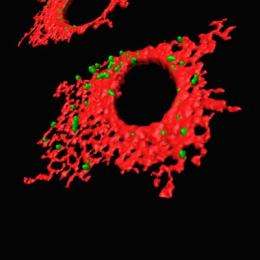How the demons of dementia possess and damage brain cells

A study from EPFL's (Ecole Polytechnique Fédérale de Lausanne) Laboratory of Neuroenergetics and Cellular Dynamics in Lausanne Switzerland, published today in the Journal of Neuroscience, may lead to new forms of treatment following a better understanding of how Amyloid-Beta found in cerebral plaques, typically present in the brain of Alzheimer's patients, may lead to neurodegeneration. Researchers in Lausanne have studied how the functions of certain cells called astrocytes-which normally protect, repair, and transfer energy to neurons-are impaired when "possessed" by aggregated Amyloid-Beta.
Alzheimer's disease currently affects more than 26 million people worldwide and estimates of up to four times as many sufferers by 2050 has made studying its causes a top priority for neuroscientists.
While the exact mechanisms by which the formation of plaques occurs and how they cause neurodegeneration and dementia is still a matter of debate in the scientific world, this study sheds a new light on how astrocytes may participate in the development of Alzheimer's disease. This new understanding of the interaction between Amyloid-Beta and astrocytes could lead to more effective therapies for Alzheimer's disease by trying to rescue astrocytic functions by deactivating the scavenger receptors.
The current study explores the causal relationship between the build-up of the Amyloid-Beta protein, associated with the formation of plaques, and the impairment of astrocyte's functions. Pierre Magistretti, director of the Brain Mind Institute and the Center for Psychiatric Neurosciences at CHUV/UNIL, and Igor Allaman, post doctoral fellow in Magistretti's lab, have succeeded in determining how built-up Amyloid-Beta infiltrates the astrocyte cells and alters their proper functioning, thus leading to the death of surrounding neurons. "To penetrate the astrocyte, the pathological protein goes through a 'scavenger' receptor." explains Igor Allaman. "Our study has shown that if we impair Amyloid-Beta build-up, or activation of this receptor, astrocytes continue to fulfill their normal neuroprotective functions even in the presence of the Amyloid-Beta."
More information: Amyloid-Beta Aggregates Cause Alterations of Astrocytic Metabolic Phenotype: Impact on Neuronal Viability, Journal of Neuroscience, March 3, 2010, issue 9













